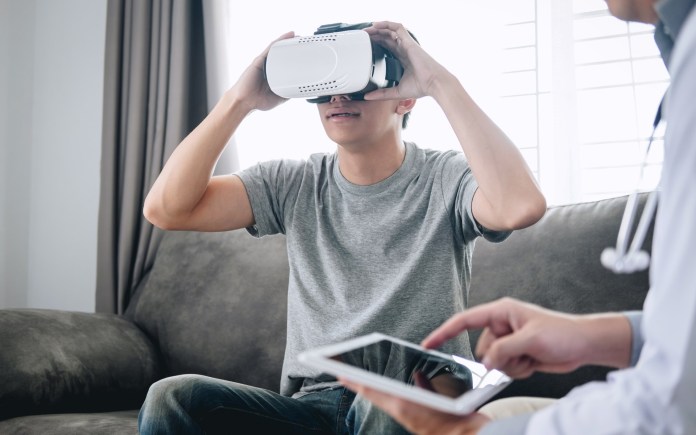Image credit: 123RF
People say therapy isn’t for everybody. But everybody should at least have the option to obtain it, and they don’t. Not only are therapy options relatively expensive, but they also aren’t accessible to everyone.
Technology is helping with not just affordability and accessibility but also with giving individuals various options for how they experience their therapy. Augmented reality (AR) and virtual reality (VR) devices, in particular, are enhancing different types of therapy and making the experience more engaging, immersive, and accessible.
Let’s look at seven therapeutic uses for AR and VR in more detail below.
An immersive remote therapy experience
The remote therapy experience previously wasn’t more than conducting an appointment over the phone or chatting with a mental health professional over a video chat. But now, remote therapy is much more immersive, thanks to VR and AR devices.
Therapists can use these devices to completely immerse their patients in a virtual world or augment their real one with digital tools and experiences that enhance their therapy.
In addition, VR and AR devices create a safe space for social interactions in this immersive remote therapy experience.
Create a safe space for social interactions
Many people enlist the help of therapists for help with mental health challenges related to socialization. But, whether it’s social anxiety or isolation induced by depression, introducing patients to social settings can be a lot safer in a virtual world.
VR devices allow patients to meet and socialize with others at their pace and make real strides toward socialization in the real world.
Aside from creating a safe space for social interactions, VR and AR devices also create a safe space for confronting triggers and triggering-events.
Confronting triggers or triggering-events
VR and AR devices can be helpful in confronting triggers. Therapists struggle to accurately recreate triggering events in real-time to help their patients through them.
But with the help of VR devices, patients can be transported to a virtual recreation of a triggering event with their therapist and essentially be hand-held through the confrontation process.
Confronting triggers and triggering events is especially significant in exposure therapy.
Exposure therapy
AR devices can be used to enhance exposure therapy. Exposure therapy is rooted in helping people overcome their fears. AR offers an avenue to confront and overcome fears via interactive digital experiences first.
Not only do AR devices make exposure therapy more immersive and engaging, but they’re also easier for patients to access and use. Moreover, augmenting exposure therapy with AR devices facilitates a controlled environment for confronting fears, adding to AR’s value and effectiveness in therapeutic care.
Eye movement desensitization and reprocessing therapy (EMDR)
EMDR is under the umbrella of somatic therapy, a form of psychotherapy that helps people navigate past traumatic events that cause their current mental health challenges.
EMDR is used mainly to help patients work through an individual traumatic memory or event. They’re asked to briefly focus on the distressing memory while participating in bilateral stimulation through eye movements. These movements can help reduce how vivid and emotionally traumatic a memory is.
The integration of VR devices in this kind of therapy allows patients to have a more immersive session at home or in their therapist’s office. In addition, working through these individual memories may become more manageable when you recreate the exact experience in an alternate world.
Music therapy
Music has naturally mood-lifting properties. So, many therapists use music to help their patients improve their mental health and navigate specific physical, emotional, cognitive, and social challenges.
Listening to music on a stereo or through a pair of headphones is one thing. But completely immersing yourself in a virtual concert, nature scene, or another music-related experience via a VR device is another.
Many patients who receive music therapy enhanced with VR or AR devices report experiencing more profound relaxation, decreased anxiety, improved cognitive ability, and better emotional stability.
Sensory integration therapy
Sensory integration therapy is primarily for children experiencing sensory-related challenges or delays. But that doesn’t mean adults living with sensory-related challenges can’t benefit from this type of therapy.
This approach is meant to help patients process sensory information and use all five senses individually and collectively. These sessions are typically rooted in play, as therapists use equipment like swings, trampolines, slides, brushes, weighted vests, balls, and crash mats to enhance treatment.
VR devices can be incredibly helpful in sensory integration therapy when patients can’t visit their therapists in person or when physical equipment isn’t available. Patients can instead strap on a VR headset and engage with equipment virtually to elicit different responses to sensation, manage sensory overload, and improve motor skills.
Conclusion
When implemented appropriately, VR and AR devices can enhance therapy sessions, whether in-person or remote. Not only can they better perform specific types of therapy, but they can also make remote therapy, in general, safer and more immersive.
Continue to watch how VR and AR devices are integrated into therapy and take advantage of these experiences should they be offered in your therapeutic journey.
Source: Seven therapeutic uses of VR and AR devices – TechTalks













